|
|
The Crew of Flt Sgt F A Pearson
Including
Sgt W H Clayton. No.1377386
Air Gunner, RAF
149 (East India Sqn) RAF
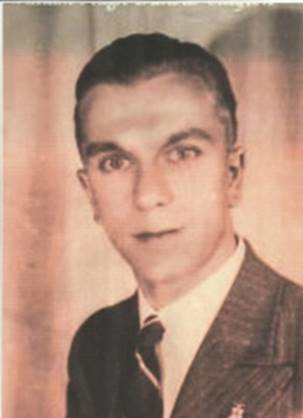
Note from Historian. Please note. Very little of this compilation is my original work. It has been produced using the superb research done by the following:
Sources
- Aircraft Research Group Achterhoek
- Air Battle of the Ruhr , Alan Cooper, Shrewsbury 2000, p. 42
- Commonwealth War Graves Commission
- Imperial War Museums .
- The article from Montferland News on the Lionel Binning page .
- Gerard Neijenhuis in De achter van Montferlands freedom , p. 75
- Old Ni-js No. 32 , pp. 32-38.
- Official report drawn up by the Marechaussee on 14 March 1943.
- The Archives and records of 149 (East India) Squadron, RAF
William Hugh Dunbar Clayton, known as Willie, was born in London on the 10th August 1912 to Nellie Florence Middleton. She immigrated to Australia shortly after his birth, after which Willie was raised in London by his grandparents.
When war broke out Willie volunteered for Aircrew and was attested for the RAF as an AC2 (Aircraftman Second Class) ready for training. In early 1942 Willie married Monica Ivy Young.
Basic Training
Willie’s Initial Training would have been at an ITS (Initial Training School ), where he would have been subject to the normal one or two days being kitted out, getting injections and being checked over by a doctor and dentist. This was followed by the usual eight weeks of Basic Training, which was more directed to making the airman into a soldier rather than an airman.
At the ITS aircrew cadets learned to march, did lots of PT and went to classes. This Basic Training was initially carried out by regular Service discipline instructors, of Corporal or Sergeant Rank. It was a great source of unhappiness that the recruits these regulars were training would be the same or higher rank than them in a relatively short time period. The Instructors were usually described by their trainees as, “... universally without Fathers….”
At the start of the war, most pilots and observers were commissioned officers or senior NCOs. The people who flew as gunners and radio operators were normally taken from the ranks of the 'Erks' (Other Ranks – those who were not commissioned, ranging from AC2 to Warrant Officer) on a squadron. Aircraftman 1st and 2nd class (AC1 and AC2), manning the guns and/or turrets and the radios was the 'norm'. As the war progressed and aircrew were shot down and captured, the authorities decided that they should make all flight crew a minimum rank of Sergeant, ostensibly to ensure that they were correctly treated if captured. Even then, the two groups were often split on capture into officers and airmen camps.
After the basic (ITS) training was accomplished, it was on to the Gunnery training, although there was also time allocated to Wireless Telegraphy for Wireless Operator/ Air Gunner trades.
Basic gunnery training
Air Gunnery School was normally for 6 weeks. The AGS instructors had almost all done a tour of Ops. (30 Operations, a full tour, was rewarded with a minimum of 6 months screened from Ops). In addition to lectures, real life incidents made the Instructors appear a grand example to the Trainees. Their schooling and comments on life in the RAF helped the trainees cope with the conditions and hardships of training. All aircrew were volunteers and could cease training before flying, without detriment to their record. Leaving after commencing flying led to a charge of LMF (lack of moral fibre).
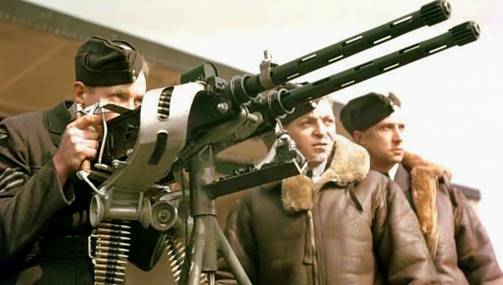
In Basic Gunnery the main thing they would have been taught was turret work. They learned how the turret lifted the guns up and down again, how to harmonise the guns - you've got four guns and so what you want to do is put the most bullets in the centre, so when you're looking down the sight you can see the dot in the middle - you want to put your bullets there. They also learned about the 'bullet drop', calculating the curve of fire and learning how to aim at targets in the air, how to build and strip down the .303 guns (eventually assembling them blindfolded) and finding faults on those guns.
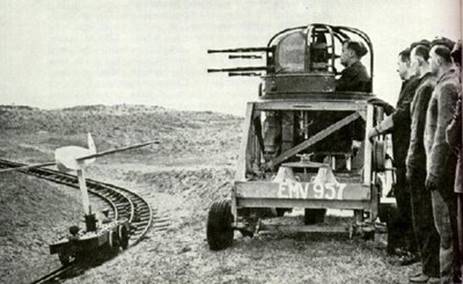
Early Air Gunner Training
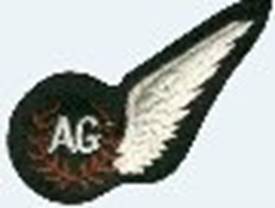
The coveted ‘Brevet’
When a trainee air gunner completed his training he was given his air gunner's brevet (The badge, shown) and promoted to Sergeant. So Willie got his “wing” and passed out, with a Sergeant's pay (around 8 shillings a day). After a spot of leave, he would have posted to an OTU (Operational Training Unit) to go through the crewing-up procedure.
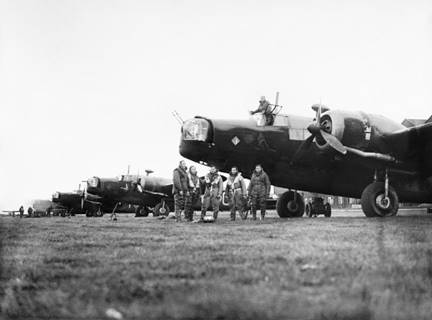
Wellington 1c – source IWM
Usually, newly qualified aircrew would group together themselves whilst at an OTU (Operational Training Unit ); a Pilot, Navigator, Bomb Aimer, Wireless Operator and an Air Gunner. The move from the Wellingtons of the OTU’s to the four engine Bombers of the HCU’s (Heavy Conversion Units) would have required the addition of two further crew members – a Flight Engineer and another Gunner, making a full crew of seven men. Willie’s initial crew were all brought together at 1657 HCU, headquartered at RAF Stradishall . There they would have done cross-country flights and other realistic scenarios to bring them up to Operational Standard. The next posting was to their Operational Unit. Willie’s arrival on 149 Squadron was as a posting to the Squadron strength with his ‘Crew’.
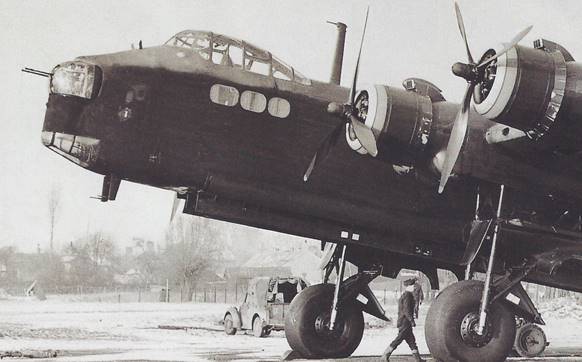
Mk 1 Stirling – source IWM
Although the Stirling could happily out-turn a Hurricane at low level, the usual bombing altitude of 12,000 to 15,000ft made them vulnerable to searchlights, flak and night fighters. Many were also lost through Take-off and Landing accidents during its service period, as well as the flak and fighters.
At the time of Sgt Clayton’s service, 149 Squadron was based at RAF Lakenheath. This was originally a relief landing field for RAF Mildenhall, but the advent of the Stirling meant that secure tarmac runways were required and Lakenheath was the choice. The main reason for the move was the notorious habit of the Stirling to develop a severe swing on take-off resulting in many fatalities over the service of the aircraft. It was also very unhappy in crosswind landings, often resulting in the landing gear being wiped off the aircraft with attendant chaos. Although RAF Lakenheath is still in operation today, it is the home of 100 ARW (Air Refueling Wing) and a squadron of F15 Strike Eagles of the USAF.
Operational Flying.
In Stirling R9334, formerly coded OJ-P and then re-coded OJ-G, which arrived on the squadron on the 25th May 1942, the original crew met with disaster. Originally logged as, “'Crashed and burnt out during night bombing practice near Lakenheath. Altimeter problem”' on 3/1/'43. A little more digging sheds light on the crash that claimed Whitlock and led to Clayton leaving Laurie Blair's crew. In Stirling R9334, OJ-G, on 3rd Jan '43, on a Night Bombing practice at Rushford bombing range, things went wrong. After being instructed to land on runway 24, the pilot (At that time, Sergeant, Laurie Blair RNZAF) realized that the drift on that runway was too high. The Stirling was noted for not liking drift on landing or take-off, and the undercarriage was very susceptible to collapse. The overshoot was not good, with two engines losing power, undercarriage still down and flaps partly out. Blair could do nothing but hold it level until it hit at the far end of the Lakenheath playing field. On the way down it had hit power cables, causing a fire, and taken off a few chimney pots. The Pilot and Bomb Aimer were both injured by the impact, Sgt Whitlock, the bomb aimer, fatally. The rest of the crew got away with minor injuries. This led Willie to request a re-assignment. He left Laurie Blair’s crew and transferred to the crew of Flight Sergeant Fred Pearson. Once Blair recovered, his whole crew went on to complete a full tour and they all survived the war. The full crew for Willie was then:
Flt Sgt F Pearson. Pilot (Captain)
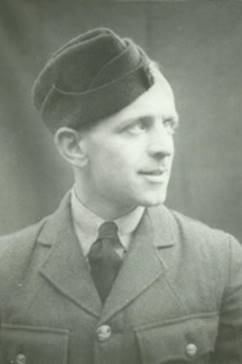 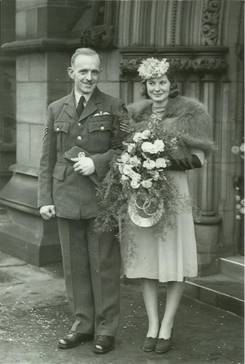
Flight sergeant Fred Alwyn Pearson (29) from Queensbury in Yorkshire was the pilot and Captain of the aircraft .
Pearson was born on 18 March 1913 as the only child of confectioner Harry Pearson and his wife Mary Ellen. He liked sports a lot - especially swimming - and played accordion. After high school, he studied languages and ethics at the University of Southampton. In 1938 he was given the opportunity to continue studying at the University of Hamburg. There he was boarding with a German professor and his family and they became fast friends. The political climate of that time, however, made it hard to stay in Germany. After an incident in which he had unknowingly worn a brown shirt in public, he was advised not to do this anymore, because otherwise he could be mistaken for a Nazi. Pearson decided to return to Queensbury. This was in 1939.
After returning he worked for over a year as a teacher at a technical school in Siddal, a suburb of Halifax, not far from Queensbury. Then he went into military service. He was inclined towards the navy, but because he was told that his capabilities in the air force would be more convenient, he went to the RAF. At that time he met Joan Marguarite Leathly, whom he married on November 29, 1941 .
He did his initial pilot training at RAF Didcot and his first operational flights in South Africa, but soon he was recalled to England and posted to 149 Squadron at Lakenheath, Suffolk. His wife lived with him in Lakenheath during the training period, but when the training was over and Pearson started to do operational flights over Europe she returned to Queensbury. There it was safer and she could better prepare for the birth of their first child. Pearson in 1942 began a six month period without leave, in which he flew bombing flights in rapid succession. On one of his first flights he had to bomb Hamburg, the city where his German friends lived. Although he did not speak or talk about it with his wife, it was clear that he had a hard time with it.
On September 24, 1942 Pearson's daughter Gillian was born. Only six weeks later, when he had leave, he could see her for the first time. The next time he saw his wife and daughter was again six months later. During this leave Pearson had some photos taken of his new family. Back at Lakenheath he had the photos developed and sent them to his wife. The postman also delivered a message that her husband was missing and probably had died. She kept her hope alive for the rest of the war, praying that he would come back. Only after the war did she receive confirmation that he had died in an Operation to Essen. Later she married Stanley Askew and moved to Helston in Cornwall.
When Pearson returned from his second leave, after his daughter’s birth, he became the pilot of Short Stirling EF330. With that he made four flights, namely on 8, 9, 11 and 12 March 1943. On the last two flights he had the same crew, so these were the men with whom he was killed.
Killed in Action.
Flt Sgt P Skinner Navigator
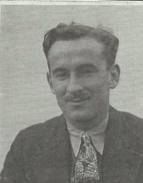
Flight sergeant Phillip Holmes Skinner (21) was the navigator of EF330. Skinner was born in Invercargill, a town on the southern tip of New Zealand's South Island. He was a serious boy who liked sports a lot; he played at the local football club and was a member of the golf club. He read a lot, mostly westerns and detectives, and saved stamps like his younger brother Galen. Their father could help them with that, because he was a postman. Although the family had to be thrifty, Phillip himself had a bicycle, which he had bought with money from a newspaper round. Another source of income was his tame ferrets Buddy the First and Buddy the Second. They caught rabbits for him, after which he sold the skins for six pence each. He also gambled on race horses, but whether he ever won is not known. After high school he worked as an office clerk at a trading company in Invercargill.
Killed in Action.
Fg. Off G Sellers. Bomb Aimer
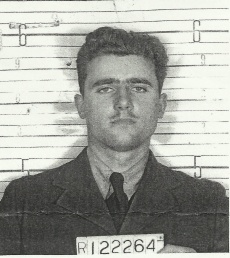
Flying officer Greaton Wesley Sellers Jr. was born on March 20th 1920 in Charleston in the US state of South Carolina as the son of Greaton Wesley Sellers Sr. and Katherine Gordon Saunders.
Sellers came from a military family. His father had fought in WWI and his brother Tom served with the Navy. The United States only became involved in WW2 on 7 December 1941, but Sellers wanted to contribute to the fight against the Nazis earlier than that. That is why he crossed the border to Vancouver, where he enlisted on 13 August 1941 with the Royal Canadian Air Force (RCAF). He was not the only one; at that time there were more Americans joining the Canadian armed forces.
In Canada, Sellers was trained as an Observer, a role that involved both navigating and bombing. With the advent of more modern bombers, this function was split into those of Navigator and Bomb aimer. On the service photo above he carries a single wing with the letter O for Observer . With the splitting of that role, the O was replaced by a B (bomb aimer or bomber ) and an N (for navigator ), but it is said that those who have received the wing with an O have often not exchanged them for a B or a N.
Note: I can confirm this. Many Observers retained their brevet against all attempts to make them relinquish them, being justifiably proud of their skills. AF.
In early November 1942, Sellers arrived in England by ship. No data is available yet about his time in England. He was a few days older than 23 years when he crashed in Beek as the bomb aimer of EF330. Although Sellers was the bomb aimer on this flight, his tombstone is marked as a navigator (bomber) - his correct RAF Trade.
Killed in Action.
Sgt. J Misseldine, Flight Engineer
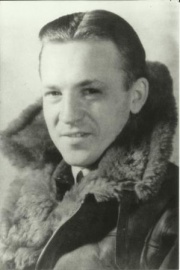
Sergeant Jack Misseldine (21) from Warboys in the former English county of Huntingdonshire was the Flight Engineer on EF330. He was born on July 31, 1921 as the only son of Joseph and Emilie Misseldine. He had two older sisters. The youngest died in 1978; the oldest wrote a letter to Hennie Freriks in 1988 containing the only photo she still had of her brother.
After high school in Ramsey, not far from Warboys, Misseldine joined the RAF in 1937. He was only sixteen years old at the time. He went to the renowned No. 1 School of Technical Training (No. 1 S of TT ) at RAF Halton in the county of Buckinghamshire, where highly qualified aircraft mechanics were trained. At the outbreak of the war he was already an accomplished engineer. Of the around one million men and women who served in the war for the RAF, only about 17,000 were trained at Halton. Despite their relatively small number, they were called the backbone of the RAF. Their technical knowledge and skills were second to none.
Unfortunately, no data is available about Misseldine's career in the RAF. He died with the seven other crew members of EF330. Six of them, including Misseldine, could not be identified.
All eight crew are on the plaque at the Canadian Memorial in Bleek-Heerenberg , which was unveiled on May 5, 2010 . Misseldine is also honored at the war memorial in his hometown, Warboys and on a plaque in the hall of his high school in Ramsey and the Roll of Honour of the Oldhaltonians , the graduates of No. 1 S or TT . Of the 17,000 of those who served in the war, 1,600 were killed; nearly ten percent. The Roll of honour is a book with the names of the fallen, which was placed on display on November 4, 2008 in a glass display in the church of Halton, the village to which RAF Halton owes its name.
.Killed in Action.
Sgt W Clayton Wireless Operator/Air Gunner
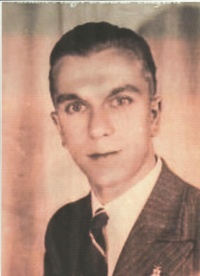
Sergeant Willie Clayton (30) was the radio operator and nose-gunner of EF330
Willie Clayton was born in London on 10 August 1912 to Nellie Florence Middleton. The surname of his biological father was Dunbar, the last name of his mother's stepfather was Clayton. Thus he was officially named William Hugh Dunbar Clayton, but he never used the name Dunbar, so he went through life as William Hugh Clayton. His mother emigrated to Australia shortly after his birth, after which Willie was raised in London by his grandparents and his uncle William Horace Middleton. Once he was an adult, he worked at the London Stock Exchange .
In early 1942 Clayton married Monica Ivy Young. When Clayton was killed in Beek in March 1943, his wife was pregnant with twins. Tragically, she died in childbirth on 13 July, four months after her husband's death. The twins - Anthony and Simon - were raised by the parents of Monica. Unfortunately the relatives of Clayton - his uncle William and his family - lost contact with the twins. They cannot therefore confirm whether the information that Anthony died in 1948 at the age of 4 is correct.
Nothing further is known about Clayton's service in the RAF. He died with the seven other crew members of Short Stirling EF330. Six of them, including Clayton, could not be identified.
Killed in Action.
W.O. G Miller Tail Gunner
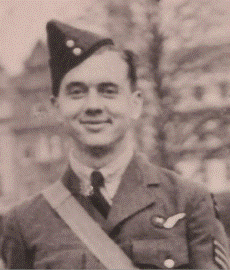
Warrant Officer George William Miller (23) from Prescott in the Canadian province of Ontario was the tail gunner of EF330.
Miller was born on 1 September 1919 as the son of George Samuel and Bernice Maud Miller. His hobbies were fishing, hunting and basketball. He was also a fanatical swimmer. His father could not swim and George saved his father from drowning on one occasion.
When he finished his schooling he first worked on a ship for seven months and then a year as an office clerk. On 20 March 1941 he volunteered to join the Royal Canadian Air Force (RCAF), where he was trained as an Air Gunner. On 1 March 1942 he sailed on a ship, Orion, to Great Britain. Eight days later he arrived in Greenock, Scotland. There he boarded the train and arrived eighteen hours later in Bournemouth in Southern England. Then he started the last part of his training.
During a training flight on July 13, 1942, Miller crashed. By a miracle, he was not seriously injured in the accident. How, he could not remember. Probably a tree had broken the aircraft’s fall. After his recovery he started a refresher course in October 1942, after which he was posted to 405 Squadron. This squadron flew with Halifax bombers at that time. Miller was sent to the air base at RAF Leeming for retraining on the Lancaster bomber. Since no Lancasters were available at that time, he was trained to be a gunner on Short Stirlings. On December 14, 1942, he was posted to Lakenheath, the home of 149 (East India) Squadron. From this airfield he left on EF330 to Essen.
On the way back the entire crew died. Initially only Miller could be identified, because he was the only person on whom a recognition tag was found. He also had 1,750 Francs with him: ten bills of 100 and fifteen of 50. Perhaps that money was a precaution in case the plane crashed into occupied France or Belgium.
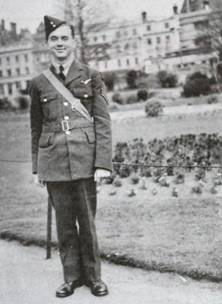 Sgt Miller on parade. Sgt Miller on parade.
Killed in Action.
Plt. Off L Binning Mid Upper Gunner.
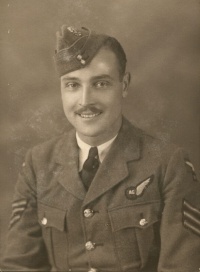
In a report published by Henny Freriks, he said in a Newspaper:
LOERBEEK - In 2002 I published (in this newspaper), in a series of six reports, the story of the crash of a four-engine Short Stirling in Loerbeek on 12 March 1943.
After the publication, it struck me that I did not have the story and the photos for three names. I then placed requests on a dozen websites in England, Canada, Australia, New Zealand and the United States. It remained quiet for three years, until November 17, 2005. In my mailbox I found an email from England. I could not believe my eyes - the sender was a niece of the Lionel Binning buried in Beek. On a website for the Royal Air Force she had found my call and answered immediately. Her sister Jacky brought me into contact with her brother, who lives in Scotland. Charles manages the family archive and before I knew it he had sent me a photo of Lionel. I also received a copy of a message from an English newspaper mentioning the death of Lionel Binning.
Lionel Binning. The Binning family originally came from Denmark, had a farming business and have been living in the county of Somerset in south-west England since the year 1663 . Lionel came from a family with four children. He had two brothers and a sister. The Binnings were a family with a military tradition. Lionel's father was a soldier and was killed in the First World War. In the 1930s the whole family served in the army. Lionel was the youngest. Lionel's eldest brother served with the RAF from 1919 until his retirement in 1958. His sister was a nurse in the army and was killed in France in 1942.The brother Ralph served with the Long Range Desert Group (LRDG) in North Africa and fought against the German African corps there.
Lionel Binning was born in the town of Pilton in Somerset. He moved to London and worked there in the Metropolitan Police Force. When the war began, he resigned from the police and signed with the Royal Air Force. I do not have much information about Lionel's career. On the photo he wears the uniform of a sergeant. He was an air-gunner in the RAF. On the uniform you see a badge with the abbreviation "AG" (Air Gunner). In EF330 Lionel was in the mid-upper turret and operated the two machine guns. I also received a newspaper cutting from Charles Binning with the title "A minimal consolation", of which a translation follows here.
The neighbours and many friends of Mrs. Binning are pleased with the news she has received from the Air Ministry about the resting place of her son LHR Binning, who was reported missing on 12 March 1943. Ms. Binning wrote: I did not know how my son died, until this week. After three years of uncertainty it is nice to know that my son has at least one grave.
The letter that the mother had received from the Air Ministry had the following content: "Referring to the previous correspondence concerning Pilot Officer LHR Binning, who was reported missing on 12 March 1943, we inform you that we, the authorities of the Royal Air Force, have received a report from the Netherlands The report states that the plane crashed in Loerbeek , Holland The remains were buried at the cemetery in Beek, municipality of Bergh (about 13 miles south-east of Arnhem ) The graves will be provided with crosses and the personal details of your son and his friends ".
The press release also stated that the body could no longer be identified. Due to the crash and explosion of the aircraft, the bodies of the crew members were unrecognizably damaged. Only the tail gunner, Miller, could be identified. The Germans first thought that seven crew members had died. From a film of the funeral a photo was placed in a commemorative book of the war in 1970. Seven coffins can be seen in the photo. Only after the war, to be precise on 6 November 1947, did Lionel Binning get his own grave. This appears from a note on a document from the municipality of Bergh in which the fallen soldiers were mentioned in the cemetery of Beek. The Lionel family plans to visit the grave in Beek soon”.
Killed in Action.
Also on board was Sgt Victor Page.
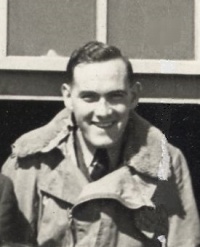
Victor was not a regular crew member, but was undergoing what were referred to as ‘Second Dickie’ flights. These were Operational trips, to accustom new pilots to Operational situations before they took their own crews out.
Sergeant Victor Page (25), born in East Ham in the English county of Essex and was the co-pilot of EF330.
Page, in 1941, joined the RAF for training as a fighter pilot. He received his practical training in Canada, but it turned out that he was unsuitable as a fighter pilot: because he became air sick in agile aircraft and manoeuvres. That is why he became a pilot of a bomber, an airplane that has intrinsic stability. The chance to become airsick in a bomber is assumed to be much smaller than in a fighter plane.
In May 1942, Page returned to England, where he arrived on 19 August at t25 OTU RAF Bircotes in Nottinghamshire. An OTU was an Operational Training Unit , a unit where aircraft crews were assembled and trained before achieving operational status. He received the last part of his training at 1651 CU, a Conversion Unit, where the crew was specifically trained on the type of aircraft they were flying with: the Short Stirling.
On 14 February 1943 the training was over and Page with his crew was assigned to 149 Squadron at the Lakenheath Air Base in the County of Suffolk. It was the custom for new pilots to fly as co-pilot on Operations with an experienced crew and pilot. This was christened their ‘Second Dickie’ trips and was valuable experience for them. Usually a Short Stirling was flown by one pilot and six crew members, but with a second dickey as co-pilot, there were eight men on board.
On the night of 10/11 March, Page flew to lay sea mines near Bordeaux. This assignment was successfully executed. The next night he was a co-pilot on a bombing flight to Stuttgart. The target was successfully attacked, but Page's plane had to return prematurely with all the bombs still on board. The next evening, 12 March, Page got another flight with the same crew and the same aircraft, Short Stirling EF330. They were on an Operation to bomb Essen. This was only his third second dickie trip . He did not return - Page's own crew stayed on the ground that night .
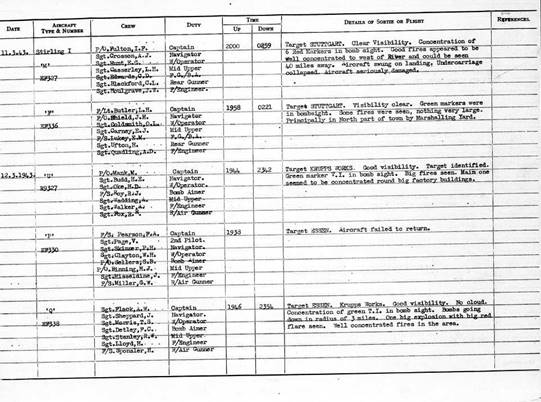
The Operational Record Book showing the loss of EF330.
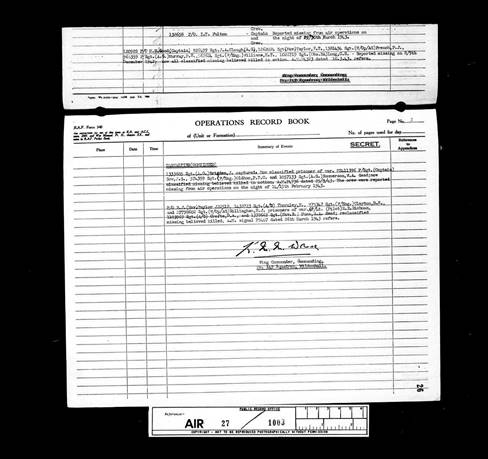
The Operational Record Book showing that Clayton was originally classed as a POW.
The crew arrived at Mildenhall on the 13th Jan 1943, minus their own Wireless Operator who had been returned to his unit. Sgt. Willie Clayton took his place.
Clayton’s Operational History.
1st Operation.
3 Feb 1943. Stirling I R9200 coded OJ-P.
Target – Hamburg.
The first trip for Willie, with this crew, was Hamburg. They did not identify the target so bombed on the glare visible through the clouds.
2nd Operation.
4th Feb 1943. Stirling III EE879 coded OJ-Q
Willie’s second trip was a long one – across the Alps to Turin. The crew bombed on the Target Indicators and considered the attack a success
3rd Operation
13th Feb 1943 . Stirling I R9200 coded OJ-P
The crew next went to Lorient, but developed engine trouble and the aircraft did not cross the coast.
Author’s note: Not crossing the coast meant that the trip would not count towards their required total of 30 trips to be rested.
4th Operation
14th Feb ’43 Target – Cologne . Stirling I W7465 coded OJ-V
The fourth trip for Willie was a bombing Operation to Cologne. Heavy cloud and they bombed in the centre of four visible flares. A big glare was seen below the clouds. .
5th Operation
25th Feb ’43 Target – Nurnberg . Stirling I EH338 coded OJ-Q
Bombs dropped on ETA.( this was a process where, from a map pinpoint, a crew could time their run on to the target and expect their bombs to land closely.) Met Ju88 near Karlsruhr and landed at West Malling.
6th Operation.
27th Feb ’43 Target – Deodars, Mining. Stirling I EF344 coded OJ-R
Mines laid as ordered.
Mine Laying Operations.
Mine laying was initially carried out from a low altitude and the mines were fitted with parachutes to ensure they entered the water cleanly. The Operations to lay these mines and deny the enemy the use of those areas were considered ‘low risk’ and suitable for ‘rookie’ crews to find their feet. The statistics showed otherwise, with very high losses being a regular occurrence. 149 Squadron pioneered high altitude Mining in late 1943, to counteract these high losses. Their technique was so good that it was adopted as standard practice for all mine-laying Operations.
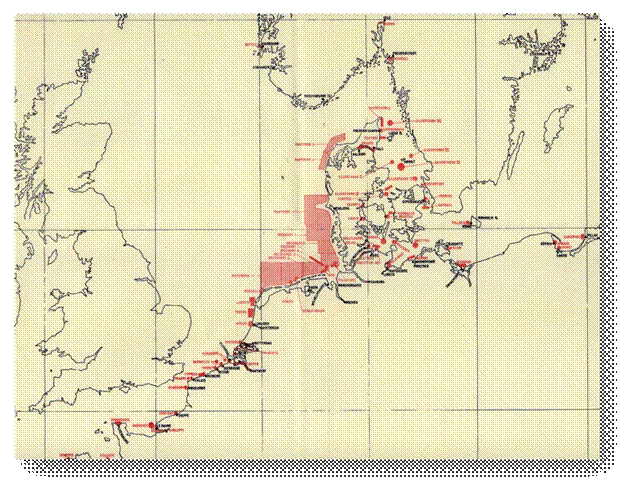
Minelaying map
7th Operation.
28th Feb ’43 Target – St. Nazaire . Stirling I EF344 coded OJ-R
Target seen in bomb sight. Red oil flare seen.
8th Operation
8th Mar ’43 Target – Nurnberg . Stirling III EF330 coded OJ-P
Target indicators seen in bomb sight. Fire glow could be seen at 200 miles.
9th Operation
9th Mar ’43 Target – Munich . Stirling III EF330 coded OJ-P
Target indicators seen in bomb sight . One very heavy explosion seen.
10th Operation
11th Mar ’43 Target – Stuttgart. Stirling III EF330 coded OJ-P
Returned early as aircraft would not climb in cloud.
11th Operation
12th Mar ’43 Target – Essen. Stirling I EF330 coded OJ-P
This account of the flight is from the group responsible for the current Memorial: (I have left in the Internet Links for those interested).
On the 12th March, 1943 this Short Stirling Mk I bomber of 149 Squadron crashed north of Beek . The night before, the crew had taken part in an attack on Stuttgart with the same aircraft, but had to return prematurely with all the bombs still on board. Now it was one of the 457 British bombers that took off that night for a bombing Operation to the huge steel mills of ‘Krupp’s’ in Essen. An earlier attack on the night of 5 to 6 March 1943 had already caused great damage; after this attack the production would almost come to a standstill. The bombs also caused severe damage in the surrounding Borbeck district.
Most bombers returned to their bases, including 52 aircraft hit by anti-aircraft guns or night fighters. Among the 23 aircraft that were lost this night was EF330 . It had taken off from RAF Lakenheath at 19.38 (British time). After the bombs had been successfully dropped over Essen, the plane was shot down over the Achterhoek by Hauptmann Wilhelm Dorman of the 3rd Staffel of Nachtjagdgeschwader 1 (Dorman’s unit was actually 9./NJG1and this was his fourth confirmed ‘kill’.)
The Stirling crashed at 22.03 (British time) near the farm of JW Giezen on the Zuidermarkweg . The farm and the wreckage of the plane caught fire; Giezen, his two eldest sons and the eight crew members of the Stirling were killed.
After the Germans released the crash site, local residents helped to salvage the mortal remains of the victims. One of those who helped was Gerard Neijenhuis . Until the funeral on 15 March, the bodies of seven crew members were retrieved. Only the tail gunner George Miller could be identified, because he was the only one on whom a nametag was found. In itself it is not strange that the eighth body was only found later, because usually the crew of a Short Stirling consisted of only seven men. As the official report below shows, the Germans were aware of this number. When there were seven corpses, one would have thought that all the dead were accounted for. On the 15th March, the seven crew members who had been retrieved were buried by the Germans with military honours at the Roman Catholic cemetery in Beek. Keub Neijenhuis secretly made film recordings from an upper window of hotel De Roos . Earlier he had had the opportunity to make close-ups of the coffins. Those of the six deaths that could not be identified are marked with signs saying "№ II UNKNOWN" to "№ VII UNKNOWN" ("№ I" was Miller's coffin). It is obvious that they were made by Neijenhuis in his carpentry shop. There are images of the ruined house of Giezen, where we can see from a distance how (probably) two dead were recovered. We also see how residents of Beek guided the coffins to the cemetery, where the crowded audience, local notables and a German guard of honour watched the ceremony. A German cleric in officer's uniform (but with a cross on his chest) spoke with a Bible in his hand, after which he made a ‘blessing’ gesture and scattered a handful of earth over the coffins. Then the guard of honour fired salute shots and the ccoffins are placed side by side in the burial plot. The final burial images were made later. Neijenhuis' children Gerard and Lenie lay a wreath on the grave that was already closed, but without crosses. After the laying of the wreath they knelt down to pray. Then we see Neijenhuis with his children standing at the grave. On the wreath are ribbons with the text "Peace in Peace" and "As a man to man - Parish Beek".
The eighth crew member was found after the 15th of March and was committed on March 20, together with the remains of Giezen and his sons, next to those of the other fallen airmen. A number of the original crosses can be seen on the photo of the re-burial by Wim Moorman .
Miller, who could immediately be identified, is in the first grave. In the second grave lies Lionel Binning , identified in 1947 . The other six airmen are in tombs 3 to 6, but not necessarily under their own headstone.
B & W van Montferland decided on 31 March 2009 that a street on the Matjeskolk Stirlingstraat industrial estate will be renamed in memory of this bomber and its victims.

The official report
The father of Wim Moorman, who was an unpaid rifleman in Beek, made an official report of the crash of this aircraft. This shows that until March 7, only seven of the eight killed crew members were found. The text of this official report follows below.
Bommerwerper crashes in Beek
Marechaussee Region Arnhem
Group 's-Heerenberg - Post Beek
Pro Justitia
No 129
Report of the crashing of a four-engine British Bomber aircraft at Beek municipality Bergh on 12 March 1943, as a result of which the farmer's residence and outbuildings of JW Giezen in Beek No 33 were destroyed by fire. Three people from the Giezen family were killed. In addition, the crash killed the seven occupants of the plane.
RECOVERY PROCESS
After we, Antonius Wilhelmus Franciscus Moorman , unpaid rijksveldwachter belonging to the aforementioned group Marechaussee, and Johannes Busser, Marechaussee, also belonging to the aforementioned group, in the evening of Friday, March 12, 1943, at about 21.45 had observed that there is in Beek municipality Bergh at the place of the house of a certain Giezen, an airplane had crashed, causing a serious explosion, followed by an extensive fire, we immediately went to the place of the incident. We noted on the date mentioned at 21.55 hours that a plane crashed just behind the farmer's house of JW Giezen in Beek municipality Bergh. It had gouged a trench of about 25 meters in length in the direction of Giezen's house. This trench showed a depth of approximately 50 centimeters at the beginning and ended in three holes at a depth of approximately 1.80 meters and a diameter of approximately 3.50 meters. Furthermore, we saw that the aircraft had been completely torn apart and the debris and destroyed parts were spread over an area of approximately 3 hectares and partly burned on the ground. In addition, we found that the medium-sized farmer's residence with two barns, belonging to and in use at JW Giezen, was completely on fire, as were two nearby sheds with corn or at least field crops, belonging to B. Willemsen in Beek municipality Bergh No 34.
In this farmer's house and barns were livestock: a horse, five cattle, one pig; also agricultural inventory and agricultural products, besides the furniture and fittings. Mentioned objects and livestock were in flames in such a way that approach was not possible, which apparently was caused by the fact that the petrol and other inflammable substances present in the crashed plane had spread completely or partly over the buildings. The fire-brigade of the municipality of Bergh, of which shortly afterwards personnel were present, could not extinguish the flames due to lack of water.
We, the reporters, then observed that the said crashed plane was a British bombing plane, which we found out from the letters present on the scattered parts and fragments. Then we learned that three members of the JW Giezen family, who had stayed in the yard of the house during the event, were no longer present.
Following this assignment, we continued the investigation on 13 March 1943. After an investigation had been carried out by the relevant German Wehrmacht authority, it appeared that on the surface of the ground there were the bodies of seven occupants of said aircraft, one of them bearing a mark with the inscription CAN-R 119377 - GWMiller – C of E. RCAF The others, who seemed to be seriously burned or mutilated, were not (or no longer) provided with such a mark of identification. For Mr. Burgemeester van Bergh, the former German Wehrmacht Commander, the remains were stored in separate wooden coffins. On the coffin in which the corpse provided with said identification mark is stored, the inscription is placed as on the aforementioned identification plate; the coffin was also numbered with Number 1. The other coffins are numbered 2 to 7 and the word 'unknown' is placed on them. The 7 bodies will be buried on Monday, March 15, 1943 at the RKkerkhof in Beek municipality Bergh. According to the German Wehrmacht authority's statement, the aircraft was a four-engine British Bomber aircraft, which is always manned by seven people. In the course of further research we have found that the three members of the Giezen family, who were lying in the yard of the house when the plane crashed, were all killed. The names of these persons are as follows:
- Johannes Wilhelmus Giezen, born in Wehl 15 March 1891, farmer, Dutchman living at Beek municipality Bergh No 33;
- Wilhelmus Bernardus Giezen, born in Bergh 19 April 1925, farmer, Dutchman living at Beek municipality Bergh No 33;
- Bernardus Reinirus Giezen, born in Bergh 30 December 1926, student, Dutchman living at Beek municipality Bergh No 33.
In the yard of the burnt house of the Giezen family, we have found burned body parts of one or more people, along with remnants of burned clothing ; they could serve as an indication that they were the remains of Giezen's family members. We will draw up a detailed record of this on behalf of the Ministry of Justice.
Of which, by taking the oath upon acceptance of our ministry, this official report is drawn up, signed and closed, while this will be handed over to the competent authority for shipment to the Lord Group Commander in 's-Heerenberg.
Beek municipality Bergh, March 14, 1943. The reporters (s / wg) Moorman, J. Busser. |
|
12 Mar 2014
BEEK / LOERBEEK - It was exactly 71 years ago on Wednesday that a plane crash took place at the Zuidermarkweg in Loerbeek. On 12 March 1943, at ten o'clock in the evening, the Short Sterling EF 330 crashed at the house of the Giezen family. Not only were 2nd pilot Victor Page and his seven-person crew killed, but also Jan Giezen and his two sons Bernard and Wim.
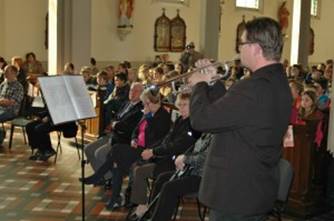
This Wednesday morning, that air disaster was commemorated in the church of Beek. This happened in the presence of the 93-year-old RAF pilot Owen Moore and his son Robin. Owen Moore was the friend of the killed pilot Victor Page and came to Beek for the second time, especially for the occasion. Also present was the Giezen family. Pupils from groups 5 to 8 of the Kolkstedeschool co-operated in the commemoration.
"Last September, you visited the grave of Vic Page at the parish cemetery for the first time", said Betty Gerritsen-Rosendaal, teacher of group 6, to Owen Moore. "This is how the contact with the Kolkstedeschool came into being. You then regretted that there was no opportunity to make contact with the children. That's why we organized this commemoration especially for you. "
Church service
In the church, children from group 6 called the names of the airmen killed. Subsequently, Emma, Karsten, Niek and Jelle read two poems in both Dutch and English. Between the two poems, music association Volharding played the song 'Freedom' by Nick and Simon. Then the four ladies Gudde from the church choir sang the most famous song of the Second World War, 'We'll meet again' by Vera Lynn.
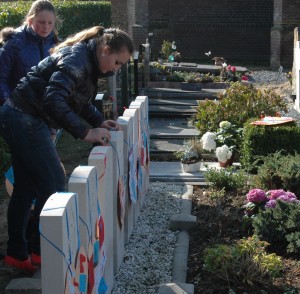
On the parish cemetery, a number of children hung remembrance hearts over the tombstones of the fallen airmen. After playing of the Last Post and a minute's silence, the English national anthem, 'God save the Queen' was played, 'especially for Owen'. Then the whole company went to the Kolkstedeschool, Owen in an army jeep in front and the children in parade at the back.
Questions
At the Kolkstedeschool the RAF pilot recieved a welcome with Dutch and British flags by children from groups 1 to 4. Inside, the pupils had the opportunity to ask the veteran a number of questions. "Was it your own choice to help the army in the war", was one of the questions. "When I was as old as you, the only thing I wanted was to fly in an airplane," Moore replied. "When pilots were needed during the war, I joined the RAF. I wanted to fly and the war offered me the chance to fly. "
"How did you feel when you heard that your friend had died?" asked another child. "It was war, you knew people could die. During the time I was in Canada, accidents happened during the training sessions. I experienced three funerals there from boys who died in those crashes. We were used to it happening. "
In gratitude that Owen Moore came to Beek again for the commemoration with the children of the Kolkstedeschool, the students of group 6 gave him two presents. For example, the Heemkundekring Bergh made a photo book of the war and the liberation in Beek for him. He also received a friends book, in which all students wrote a message and dream. "I could never have imagined that I had so many friends in the Netherlands," Moore said in conclusion.
Compiled by Alan Fraser
149 (East India) Squadron Historian and Archivist
Further Sources:
Dave Giacomelli (with thanks)
http://www.berghapedia.nl/index.php/Short_Stirling_EF330
149 Sqn Archives
149 Sqn ORBs
W Chorley’s BCL Vol IV
J Johnston’s ‘Strong by Night’, a history of 149 Squadron.
Theo Boiten’s Nachtjagd War Diaries
Various Internet Forums.
It is with humble thanks that I acknowledge the efforts that the Dutch people make to honour our War dead. Would that our own Government could follow their example.
Alan Fraser
|
|
 Stirling Pilott
Stirling Pilott 
 Stirling Pilott
Stirling Pilott 